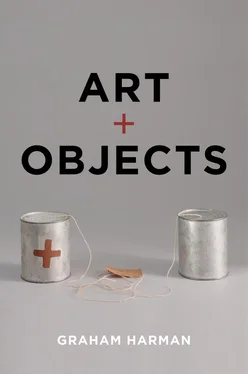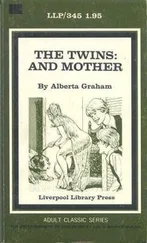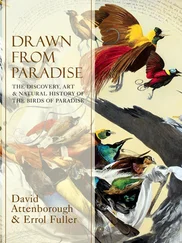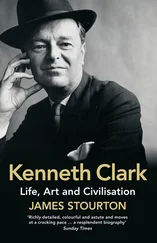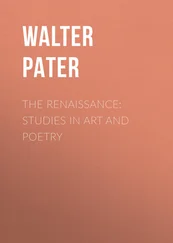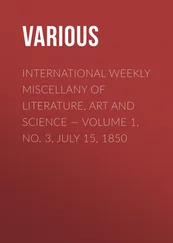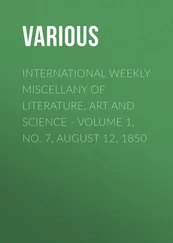Metaphor and its Implications
We are now ready to turn to art. Although this book deals primarily with the visual arts, there are good reasons to start with a discussion of metaphor, which shows us the workings of art more generally in lucid form. How so? Because metaphor is easy to contrast explicitly with literal language, and it turns out that whatever else art may be, it cannot have traffic with any form of literalism. This is the point of closest approach between OOO’s theory of art and that of Fried, to be discussed in Chapter 3below. This does not rule out considering, say, Marcel Duchamp’s ready-mades as art, but merely requires that we find a non-literal element in them if they are really to qualify as art.
By aesthetics , OOO means the general theory of how objects differ from their own qualities. Given that there are two kinds of objects and two of qualities, there are four separate classes of aesthetic phenomena: RO-RQ, RO-SQ, SO-SQ, and SO-RQ. Generally speaking, RO-RQ is the tension at stake in causation of every type; the old philosophical topic of cause and effect is thus brought for the first time under the banner of aesthetics, where it rightfully belongs. 17RO-SQ is a less surprising aesthetic tension, the one that deals with our perception of objects under constantly changing appearances and conditions, of the sort that Husserl meant whenever he talked about adumbrations; we will soon see that this tension was noticed by Kant in the Critique of Judgment as well, under the name of “charm.” SO-RQ, which again owes so much to Husserl, concerns the tension between the objects that appear to us and the real qualities that make them what they are; it is here that we find “theory” in the sense of cognitive understanding. It is only with the RO-SQ tension that we find beauty , which I do not hesitate to insist is the domain of art, even if most artists today want nothing to do with beauty, but would rather sidestep that question in favor of some socio-political topic or other, given that emancipatory politics is the great intellectual piety of our era. On this score, the situation described by Dave Hickey in The Invisible Dragon has not significantly changed, despite his misleading mention of politics: “If you broached the issue of beauty in the American art world of 1988, you could not incite a conversation about rhetoric – or efficacy – or pleasure – or politics – or even Bellini. You would instead ignite a question about the marketplace.” 18For OOO, the meaning of beauty is not some vague appeal to an illdefined aestheticism, but is explicitly defined as the disappearance of a real object behind its sensual qualities. For reasons soon to be explained, this always has a theatrical effect, and beauty is therefore inseparable from theatricality – despite Fried’s understandable insistence to the contrary.
In any case, the OOO theory of metaphor owes much to an important but neglected essay on the topic by the Spanish philosopher José Ortega y Gasset, who was more widely read during the heyday of existentialism than is the case today. 19Here I will not repeat my interpretation of Ortega’s essay, but will simply present the revised OOO theory that emerged from it. 20In the past, I have always used metaphors from renowned poets; this time I will choose a homely anonymous example found at random in a Google search. It comes from a poem that most intellectuals would scorn as sentimental greeting card verse, though it works perfectly well for our purposes:
A candle is like a teacher
Who first provides the spark
That kindles love of learning
In children’s minds and hearts. 21
If it helps the reader to take it more seriously, we can pretend that this is simply the first stanza of a morbid poem by the Austrian expressionist Georg Trakl, one that soon takes a darker turn toward cocaine, incest, and extinction. Let’s also simplify the exercise by limiting ourselves to the first line: “a candle is like a teacher.” Next, we should contrast this statement with the dictionary definition of a candle. When I enter “definition of candle” into Google, here is what comes up first: “a cylinder or block of wax or tallow with a central wick that is lit to produce light as it burns.” For good measure, let’s also use Google to look up the definition of “teacher.” This is the first result: “a person who teaches, especially in a school.” If we combine the two definitions to replace the original metaphor, the result is perfectly ridiculous. Namely:
A candle is like a teacher.
becomes
A cylinder or block of wax or tallow with a central wick that is lit to produce light as it burns is like a person who teaches, especially in a school.
While somewhat amusing, the second statement is not only unwieldy, but utterly absurd. Yes, we might imagine a master poet of Dada who could pull off this line in a poem, and therefore we hesitate to exclude it from art for all eternity. Yet barring the rare appearance of such a master, there is nothing but sheer literality when we read “a cylinder or block of wax or tallow with a central wick that is lit to produce light as it burns is like a person who teaches, especially in a school.” Like every definition taken in isolation, this joint definition is structured as a literal identity. But since under normal circumstances the combined identity is patently false, we are not sure what to make of the statement. Though we mentally repel the second statement in the same way that we hold all nonsense at a distance, we do not do the same with the original poem, even if we regard it as cloying kitsch. “A candle is like a teacher” is somehow able to draw us into its atmosphere to a sufficient extent that we take it with at least provisional seriousness. We see immediately that this is not a literal statement of the sort we expect from scientific or other knowledge. But what makes the two cases different?
A literal statement treats objects, explicitly or not, as interchangeable with a list of the qualities it possesses. 22Imagine speaking with someone who had somehow managed to go through life without ever hearing the word “candle,” despite a relatively large overall English vocabulary. In such a case, we could repeat the dictionary definition and instruct this person that a candle is a cylinder or block of wax or tallow with a central wick that is lit to produce light as it burns. This definition gives knowledge about what a candle is. It does this by deflecting our attention away from the candle itself in two opposite directions. First, it undermines the candle by telling us what it is made of: “a cylinder or block of wax or tallow with a central wick.” Next, it overmines the candle by telling us what it does: “[it] is lit to produce light as it burns.” In the effort to instruct our ignorant acquaintance, the candle is treated as purely equivalent to the sum of its physical composition and its external effects on the world at large. The same holds for the definition of a teacher. If somehow our friend also does not know what “teacher” means, we can give him this knowledge by moving in the same two directions. Looking downward (undermining) we find that a teacher is “a person,” since human beings are the raw material from which all teachers so far have been made. We can also look upward (overmining) to learn that the teacher is someone who “teaches, especially in a school.” Here once more we gain knowledge, and knowledge always entails that an object is replaced by an accurate description of its components, apparent properties, or relations. No aesthetic effect occurs, and hence there is no beauty. We have nothing but paraphrase: nothing but literalism . There is no sense of any surplus in the candle or the teacher that goes beyond what we get from adequate definitions of them. Even if these definitions leave out numerous additional details about candles and teachers, we are already on the right track, and cease defining them further only because we have already conveyed enough information for the person to grasp what we mean.
Читать дальше
